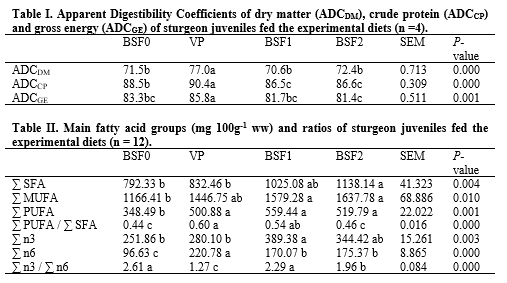BLACK SOLDIER FLY FED TO STURGEON Acipenser baerii JUVENILES: DIGESTIBILITY AND WHOLE BODY COMPOSITION
Introduction
The role of aquaculture is determinant for the global fish production and for the supply of the increasing demand for fishery products. Aquaculture is currently facing sustainability issues, among which the supply of new and eco-friendly protein sources. Researches have highlighted that insect-based protein meals could represent a valid and sustainable alternative to conventional protein (fish or plant protein meals) (Gasco et al., 2016). Recent amendments of the Annex IV to Regulation (EC) No 999/2001 on processed animal proteins (PAPs) will authorize the use of PAPs from insect from July 2017. Black soldier fly (Hermetia illucens - BSF) is listed among the insect species that can be used. This research aimed to evaluate the effects of dietary inclusion of a defatted BSF larvae meal on whole body composition and in vivo dry matter (DM), crude protein (CP) and gross energy (GE) apparent digestibility (ADC) of juveniles sturgeons (Acipenser baerii).
Materials and methods
Four diets were formulated to be isonitrogenous and isoenergetics (on wet basis: CP 50.5%; GE 20.6 MJ kg−1): i) control diet (BSF0) in which fishmeal (FM) was included at high level (70%) and represented the main protein source; ii) two diets where BSF (was included at 18.5% (BSF1) and 37.5% (BSF2) substituting 25 and 50% of FM control diet, respectively; iii) a vegetable protein based diet without BSF meal (VP). The latter diet was formulated to mimic the commercial feeds. In order to perform ADC measurements, the indirect acid-insoluble ash method was used adding 1% celite® to the diets as inert marker. Quadruplicate groups of fish (22 fish / tank) were fed to apparent satiation, three times a day, six days per week. To perform the digestibility trial, three hours after the two first feeding, apparently fresh and intact faeces were siphoned and frozen (-20°C) until analysis. At the end of the trial, 12 fish per diet were slaughtered for the determination of the whole body proximate composition, gross energy and fatty acid (FA) composition. Data were analysed by one-way ANOVA (post-hoc test: Tukey) and significance was declared at P ≤ 0.05.
Results
The ADC of DM, CP and GE of the diets are reported in Table I. Differences appeared between the diets for all the considered parameters. Overall, VP group recorded the best ADC values followed by BSF0 and BSF treated groups. In particular, this trend was more evident for the ADCCP that decreased from 90% for VP to 86% for BSF1 and BSF2 diets. Dietary treatments influenced the final whole body proximate composition of sturgeons. The DM of fish fed BSF2 (23.37 g 100 g-1) was different from BSF0 and VP (21.25 and 21.30 g 100 g-1, respectively (p-value: 0.002). Moreover, the fish fed the highest BSF inclusion level also reported a different ether extract (EE) content (6.23 g 100 g-1) if compared to BSF0 (4.50, g 100 g-1) (p-value: 0.016). Crude protein (CP) and ash did not differ among treatments. Table II reports the main FA groups of the fish fed the experimental diets.
Discussion
ADC values showed that the BSF inclusion affected the nutrient and gross energy digestibility; similar results were found in a trial with turbot juveniles fed diets containing increasing levels of BSF meal (Kroeckel et al., 2012). The lowest CP digestibility could be related to the chitin content provided by the BSF meal. The inclusion of BSF influenced both fish whole body composition and FA profile. The EE content grew with the dietary increase of insect meal as reported by Dong et al. (2013) who also noted no differences for CP content. As far as FA profile is concerned, generally, the whole body FA composition reflects the dietary FA profile. Due to the high lauric acid (C12:0) content in BSF meal, this FA was higher in fish fed BSF diets (61.23 and 151.61 mg 100g-1 ww for BSF1 and BSF 2 respectively) than in fish fed diets without BSF (2.7 and 2.42 mg 100g-1 ww in BSF0 and VP, respectively). Such results agree with the findings of St-Hilaire et al. (2007) who fed rainbow trout with BSF pre pupae meal. Saturated fatty acids (SFA) in BSF2 fish were higher than in BSF0 and VP treatments. As far as monounsaturated (MUFA) and polyunsaturated (PUFA) fatty acids are concerned, our results indicated differences with lowest values recorded for BSF0.
References
Gasco, L., Henry, M., Piccolo, G., Marono, S., Gai, F., Renna, M., Lussiana, C., Antonopoulou, E., Mola, P., Chatzifotis, S., 2016. Tenebrio molitor meal in diets for European sea bass (Dicentrarchus labrax L.) juveniles: Growth performance, whole body composition and in vivo apparent digestibility. Anim. Feed Sci. Tech., 220, 34-45.
Kroeckel, S, Harjes, AGE, Roth, I, Katz, H, Wuertz, S., Susenbeth, A., Schulz, C. 2012. When a turbot catches a fly: Evaluation of a pre-pupae meal of the Black Soldier Fly (Hermetia illucens) as fishmeal substitute - Growth performance and chitin degradation in juvenile turbot (Psetta maxima). Aquaculture, 364-365, 345-52.
Dong, G.F., Yang, Y.O., Song, X.M., Yu, L., Zhao, T.T., Huang, G.L., Zhang, J.L. 2013. Comparative effects of dietary supplementation with maggot meal and soybean meal in gibel carp (Carassius auratus gibelio) and darkbarbel catfish (Pelteobagrus vachelli): growth performance and antioxidant responses. Aquac. Nutr., 19(4), 543-554.
St-Hilaire, S., Sheppard, C., Tomberlin, J.K., Irving, S., Newton, L., McGuire, M.A., Sealey, W. 2007. Fly prepupae as a feedstuff for rainbow trout, Oncorhynchus mykiss. J. World Aquacult. Soc., 38(1), 59-67.
